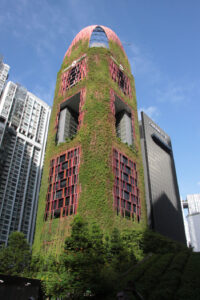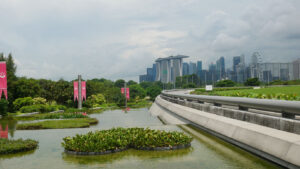Behind the scenes tour of the city in a garden
By Karen Smith
As travel restrictions eased, our ‘Behind the Scenes study tour’ of Singapore, scheduled for two years ago, finally took place recently and it was well worth the wait. Biophilic design at its best in ‘the city in a garden coincided with the Biannual Singapore Garden Festival.

A combined tour organised for members of the Interior Plantscape Association and the Australian Institute of Horticulture was jammed packed with a variety of sites to delight a group of horticultural plant addicts. We were hosted by representatives of the horticultural community who were most welcoming, and I commend their patience when bombarded with so many horticultural questions. Many thanks to John Tan (Tan Chee Hian John), a multi-awarded horticulturist and landscape designer who was an invaluable source of information and our ever-patient guide.
I always consider Singapore a ‘work in progress’. Having been there several times over many years, I am always impressed by the subtle changes to the built environment. The architectural ethos in Singapore is encouraged to incorporate as much green space as possible. Having gardens, roof gardens and green walls is rewarded by allowing the developer to increase floor space. Having green space and water features also increases the ‘liveability’ of a building which otherwise might contribute to a concrete jungle look. Several times during our visit our group was hosted by community gardeners. Communal gardens in Singapore have been actively encouraged and supported by NParks, and are seen as an essential part of developing and maintaining the Garden City of Singapore.
The Singapore Garden Festival was an extension of this idea of a ‘garden city’ by building the display gardens in a busy city plaza on a busy city street, so that all citizens passing by couldn’t help but be a part of the festival.
Australia was represented by Christian Jenkins, whose design ‘Inner Growth Garden’ was awarded a gold medal.
Christian was quoted as saying in The Straits Times “As people become busier with work, especially in Singapore, gardens can help them recharge. I’d like visitors to feel a nice connection inside their hearts, a sense of calmness and happiness.”


The Singapore climate is generally hot and humid. Ideal for many plant varieties but less so for us southerners. What better than to enjoy ice cream at the Singapore Botanic Gardens which is short ride away on the air-conditioned underground light rail system. You need more than an afternoon to enjoy these gardens but if you are pressed for time, I recommend a visit to the orchid garden attached to the botanic gardens.
Open green space for the enjoyment of their population is part of the development of Singapore. The botanic gardens being one example, and a more recent example, the development at Jurong Lakes. This evolving development provides open space and activity centres that any of the population can enjoy, and is constructed and overseen by NParks, a government organisation similar to National Parks in Australia.
I noticed a few novel innovations such as an information robot roaming the pathways, and robotic grass cutting. The gardens at Jurong Lakes encourage young people to participate by exploring and finding wildlife such as butterflies and moths. Discovery gardens encourage people to link insects and other animals to the health of the environment.
As an example of the desire to maximise open space for the use of the population there could be no better example than the Keppel Marina East Desalination Plant. The desalination equipment is situated beneath a lush green rooftop surrounded by parkland and open to the community for recreation. The parkland is part of the park connector network designed for walking and pushbikes. The use of cars is discouraged.
Singapore is an example of high density living and high-rise developments cannot be avoided. The hard lines of tall buildings are softened as many of the buildings embrace biophilic design so that everyone has access to green space wherever they are. Highlights for me were the Kampung Admiralty development and Oasis Terraces. These developments are a combination of community plaza, medical centre, commercial and residential units almost covered in plantlife supported by a community garden, and the Enabling Village which combines training for disabled members of society with retail and lifestyle green space. The Khoo Teck Puat Hospital is a perfect example of what can be done when designing efficiency into a building from the beginning, incorporating a central, cooling green space, breeze directing external fins, light reflectors and views over the scenic Yishun Pond. Much of the roof space of the hospital is committed to gardens growing edibles for consumption within the hospital, and for the recovery and rehabilitation of patients.

Many of the buildings we saw incorporated roof top gardens and green walls. CapitaSpring, Marina One Tower, Oasia Hotel Downtown and Park Royal were all examples of high-rise developments incorporating green spaces in the core of the building and on the roof. CapitaSpring housing, a mix of commercial and residential units, had a complete roof top garden on the 51st level providing produce for a restaurant in the building. A green space in the core of the building provided powered quiet areas for office workers who wished to be away from their desks.
Marina One Tower, also a mix of residential and commercial units, was another example of a design that invited breezes through the building reducing any need for air conditioning in the common areas. The ground area made use of a large planting of palms and tropical broad-leafed plants coupled with a cooling water feature.

Oasia Hotel Downtown and Park Royal are high-rise hotels incorporating open green spaces through the core of the building. Mr Jevers Choo, of Mao Sheng Quanji Construction Pty Ltd, kindly conducted us through the Park Royal site explaining the philosophy and difficulties with the design and construction of the many green walls and hanging gardens that give this iconic building it’s character. One side of the Park Royal faces an older social housing building. To improve the outlook from this building, the facing side of the Park Royal Hotel is covered in gardens providing a softer green view for the social housing residents. The Oasia Hotel Downtown is essentially a 27-storey vertical garden. The external walls form a living green façade complemented by internal garden areas promoting social interaction and providing space for recreation. Various species of climbing plants cover the external walls, each finding its optimal aspect and providing an ecosystem supporting insects and birds. The roof is a pool area surrounded by a 30m high tropical garden.
Returning to Sydney Airport put the Singapore journey into some perspective. In the arrivals hall we are greeted by a display of poorly maintained plastic plants. Having just left Changi airport and the incredible development that is Jewel, with horticultural and floral displays, water features and various eating options, our international gateway is a poor comparison.
Thanks must go to AIH President Michael Casey for organising the itinerary which squeezed a lot into each day but we were all keen to see more, and I am sure people would be putting their hands up again if a future study tour is organised.
“As a specialist working in green infrastructure, it was an honour and very rewarding to be afforded the opportunity to showcase projects around Singapore, and highlight not just the visual benefits that green infrastructure brings but more importantly, the environmental and social benefits.
Sharing these experiences and projects with likeminded professionals is reassuring, in that best practices are being showcased which is of significant benefit when we’re trying to encourage more professionals enter into this field of work” said Michael Casey.



